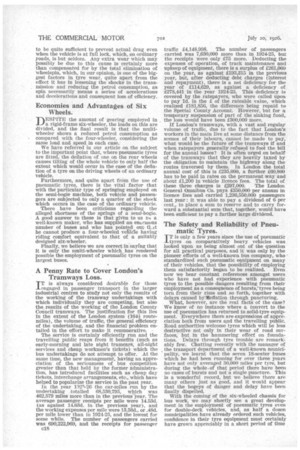A Penny Rate to Cover London's Tramways Loss.
Page 2

If you've noticed an error in this article please click here to report it so we can fix it.
TT is always considered desirable for those .1..engaged in passenger transport in the larger industrial centres to study not only the results of the working of thetramway undertakings with which individually they are competing, but also the results of the working of the London County Council tramways. The justification for this lies In the extent of the Landon system (1641 routemiles), the volume of traffic, the general efficiency of the undertaking, and the financial problem entailed in the effort to make it remunerative. The service is certainly efficiently run and the travelling public reaps from it benefits (such as early-morning and late night tramcars, all-night services and cheap workmen's tickets) which the bus undertakings do not attempt to offer. At the same time, the new management, having an appreciation of the. seriousness of bus competition greater than that held by the former administration, has introduced facilities such as cheap day tickets, interchange arrangements, etc., which have helped to popularize the service in the past year. In the year 1125-26 the car-miles run by the undertaking totalled 68;530,795, which was 462,579 miles more than in the previous year. The average passenger receipts per mile were 14.53d. (as against 14.63d. in the previous year), and the working expenses per mile were I3.56d., or .48d. per mile lower than in 1924-25, and the lowest for some while. The number of passengers carried was 690,222,969, and the receipts for passenger c18 traffic £4,148,998. The number of passengers carried was 7,630,000 more than in 1924-25, but the receipts were only £75 more. Deducting the expenses of operation, of track maintenance and upkeep of equipment, there is a surplus of £261,060 on the year, as against £193,315 in the previous year, but, after deducting debt charges (interest and repayment), there is a net deficiencyfor the year of 1114,629, as against a deficiency of £278,441 in the year 1924-25. This deficiency is covered by the ratepayers, who were called upon to pay id. in the £ of the rateable value, which realized £181,856, the difference being repaid to the Special County Account. However, but for a temporary suspension of part of the sinking fund, the loss would have been £300,000 more. If London's tramways, with a vast and regular volume of traffic, due to the fact that London's workers in the main live at some distance from the scenes of their labours, cannot be made to pay, what would be the future of the tramways if and when ratepayers generally refused to foot the bill for the annual losses? It is often urged on behalf of the tramways that they are heavily taxed by the obligation to maintain the highway along the routes traversed by them. In London the total annual cost of this is £235,000, a further £60,800 has to be paid in rates on the permanent way and about £1,200 in vehicle licence fees. The total of these three charges is £297,000. The London General Omnibus Co. pays £350,000 per annum in licence fees and carried 1,236,550,000 passengers last year: it was able to pay a dividend of 6 per cent., to place a sum to reserve and to carry forward a substantial KUM that, together, would have been sufficient to pay a further large dividend.






























